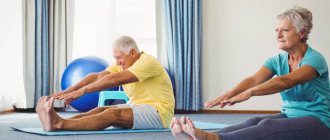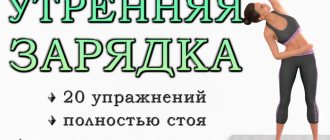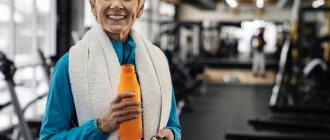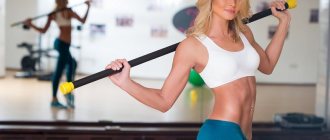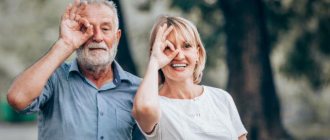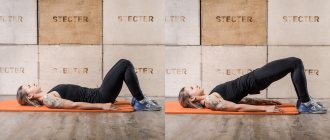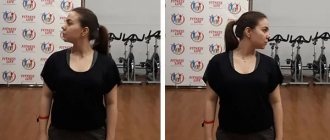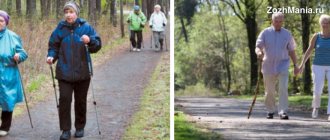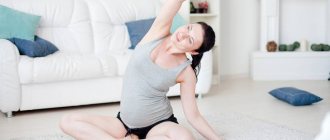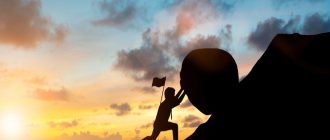Over the years, the usual workload becomes more and more difficult. As you age, it is noticeable that ordinary household chores, working in the country, playing with grandchildren, caring for pets and much more quickly cause fatigue. Pain in the joints, back, and general weakness gradually appear. How to alleviate the condition? For many, maintaining an active lifestyle and exercise for the elderly helps with this.
Features and benefits of gymnastics in old age
Exercises for older people are recommended to be done at least 3-4 times a week.
The benefits of such gymnastic complexes are:
- beneficial effects on the cardiovascular system (physical activity accelerates lymph flow and blood flow, thus maintaining the heart muscle and vascular walls in good shape);
- improving the functioning of the nervous system (promotes stimulation of the higher parts of the central nervous system, which lose their activity due to age-related changes);
- improved posture (due to strengthening of the muscular corset of the back and arms);
- weight loss (especially important for older people who had problems with excess weight even in their youth);
- positive effect on the functioning of the respiratory organs;
- minimizing the development of venous diseases, for example, thrombosis or thrombophlebitis (achieved by accelerating blood flow through the body, due to which changes in its consistency or the formation of stagnation become impossible);
- maintaining full motor activity and self-care skills;
- prevention of diseases of the skeletal system and joints;
- minimizing the risk of developing inflammatory processes in the lungs;
- normalization of the gastrointestinal tract;
- stimulation of the body's immune system;
- promoting the regenerative properties of the skin;
- preventing memory loss or deterioration;
- improved hearing;
- eliminating depression and its further replacement with a positive attitude.
Among the key features of charging for the elderly are:
- coordination of each exercise with a doctor who has an understanding of the health of a particular person;
- maximum slow increase in load;
- uniform distribution of load on muscle groups throughout the body;
- absence of discomfort and pain during exercises;
- the greatest effectiveness from sports can be achieved by combining physical activity with sports;
- strict adherence to breathing frequency;
- before performing the main part of the complex, it is necessary to warm up (if performing exercises to warm up the muscles is physically impossible, the elderly person should walk around the room at a slow or medium pace for 10-15 minutes, setting the speed of the cardiovascular system).
Contraindications
The use of physical education for older people should be avoided if they have the following health conditions:
- Pathologies of internal organs during the period of exacerbation, characterized by depression of their natural functionality;
- Aneurysm of the heart and large vessels;
- Changes in the psyche associated with memory loss, inability to navigate in time and space, reactions inadequate to the situation;
- Urinary incontinence;
- Muscle thinning;
- Dystrophic disorders in joint and bone tissue.
Note!
Exercise therapy classes for older people who have crossed the age limit of 70 years are carried out only under the supervision of a medical professional and on an individual basis.
Stretching before exercise
Exercise for older people should begin with stretching exercises. They not only warm up the muscles, but also prepare the joints for further stress, and restore the mobility and flexibility of the ligaments lost with age.
Before starting to stretch, the athlete should spend 5-10 minutes. cardio loads.
It could be:
- jogging at a slow pace in the fresh air;
- walking in place at an average pace;
- riding a bicycle or exercise bike;
- swing your arms at a fast pace.
When doing stretching, you need to feel the measure. After the initial set of exercises, an elderly person should achieve a feeling of maximum stretching of the muscle corset without pain and discomfort. Otherwise, the athlete risks injury to joints, tendons, and causing sprains or tears in ligaments.
The most effective exercises for the introductory complex are:
| Exercise | Scheme of its implementation |
| Neck stretch | 1. Sit on a chair, resting your straight back on the supporting part of the structure. Leave your arms along the body in a free position. Bend your knees at an angle of 90 degrees and place them close to each other. 2. Slowly tilt your head forward, avoiding sudden movements. 3. Having reached the limit point, fix the position for 10 seconds. 4. Slowly, without pausing in the starting position, move your head back. 5. Save the position for 10 seconds. After completing the required number of repetitions of steps 2 - 5, you should tilt your head to the right - to the left, taking the above algorithm as the basis of the technique. |
| Hand stretching | 1. Clench your hands into fists as tightly as possible. 2. Relax the wrist muscles. 3. Alternately bend and straighten each finger on both hands. 4. Straighten the brush. Without using your other fingers, move your thumb as far away from your palm as possible. 5. Press your thumb into your palm. 6. Repeat steps 1 – 5 at least 10 times. |
| Leg stretching | 1. Sit on a chair. Place your feet on your heels. Squeeze your toes as tightly as possible. Fix them in this position for 10 seconds. Slowly release. 2. Perform circular rotations alternately with the right and left feet in the air, periodically changing the direction of their movement. 3. Raise your right leg, bend it at the knee and pull it towards you. Relax your muscles. Repeat with the left leg. 4. Bend your leg at the knee. Without changing the bend angle, raise the limb as high as possible from the floor, while remaining in a sitting position. Repeat with the other leg. |
Setting reasonable goals
The morning exercise routine for people 50 years of age and older is not intended to set personal records in running, weight lifting, or long-distance swimming. The main goal of daily gymnastics is preventative. That is, your properly organized morning workout will not allow the development of diseases that are associated with age: atherosclerosis, oncology, metabolic disorders.
After 50 years, all metabolic processes proceed more slowly than in young people, and if a person deprives himself of physical activity, he begins to age progressively. “Slow” metabolism leads to nutritional disturbances in the joints, spine, and all internal organs. Moderate exercise is the best way to stimulate metabolic processes.
For both older women and men, exercise is the simplest and most accessible means of maintaining beauty, health and physical activity even in adulthood.
Health-improving exercises
Complexes of health-improving exercises for older people differ in the level of complexity and intensity of their implementation.
Morning work-out
Charging helps to normalize the speed of metabolic processes, accelerate blood flow and lymph flow after a person has been in a horizontal position for a long time. It should be performed immediately after waking up, on an empty stomach. After completing the complex, you are allowed to eat only 30 minutes later.
As a result of regular exercise in the morning, older people will be able to achieve:
- straightening the spinal column;
- strengthening the muscles of the back and limbs;
- normalization of the condition of intervertebral discs;
- minimizing the risk of developing joint diseases, osteoporosis, osteochondrosis, and so on.
A morning set of exercises performed by an elderly person should include:
| Exercise for morning exercises | Proper execution |
| Crisscross | 1. Sit on a chair; place your feet on the floor; hands - in a free position; Lean your straight back on the supporting part of the furniture. 2. Place your right foot on top of your left for “one time”. 3. On “two,” return the right limb to its place. 4. On “three” and “four” repeat steps 2 – 3 with the left leg. |
| Airplane | 1. Get on all fours, choosing the floor as the supporting surface. 2. Extend your right arm to the right. Stay in this position for 5 seconds. 3. Return the right limb to its place. 4. Repeat step 2, moving your left hand to the left. |
| Bird | 1. Sit on a hard supporting surface. Straighten your back, position your limbs randomly. 2. Extend your arms to the sides. Hold for 2 seconds. 3. Move your upper limbs above you. Stay in this position for 2 seconds. 4. Return your hands to the starting position. 5. Tilt your body forward, trying not to bend your back. 6. Without pausing, return the torso to its place. |
| Starfish | 1. Lie on the floor. Straighten your limbs in their natural direction. 2. Move your right arm and left leg to the right and left, respectively. 3. Pause for 5 seconds. 4. Return the limbs to their place. 5. Without bending, move your left arm and right leg to the left and right, respectively. 6. After 5 seconds, return to the original position. |
Calm pace
People over 60 years of age, regardless of their sports background, are recommended to exercise at a calm, measured pace.
Regular classes according to a correctly designed program will help the elderly:
- get rid of stiffness when moving your arms or legs;
- minimize the manifestations of joint diseases;
- speed up metabolism;
- make muscles more elastic;
- increase the mobility of joints and ligaments;
- reduce dizziness and other manifestations of discomfort during prolonged stay in an upright position.
Fitness trainers specializing in classes with older clients, as well as therapists, recommend using the simplest loads to exercise at a calm pace:
| Gymnastics exercise at a slow pace | Proper execution |
| Wings | 1. Stand up straight, bringing your shoulder blades together as tightly as possible with your shoulders down. 2. Extend your arms straight to the sides. 3. Bend your elbows and then touch your shoulders with your hands. 4. Pause for 2 seconds. 5. Straighten your arms without changing the distance from the floor to your limbs. 6. Repeat steps 3 – 5 the required number of times (at least 10). |
| Side bends | 1. Take a vertical position; put your hands on your belt; bring the legs into a comfortable state for a long stay in a fixed position. 2. Extend your right arm above your head. Tilt your body to the left, avoiding jerking. 3. Return to original position. 4. Extend your left arm above your head. Slowly tilt your body to the right. 5. Take the starting position. |
| Hip thrusts | 1. Stand up straight; Bend your arms at the elbows and clasp your fingers together in the chest area. 2. Without changing the position of the body, push to the right, using only the lower part of the body. 3. Without stopping, push to the left in the same way. |
| On tiptoe | 1. Stand up straight, place your feet as close to each other as possible. Place your hands on your belt. 2. Slowly bending your knees, alternately lift your right and left heels off the floor. 3. Perform steps for at least 3 minutes. |
Fast pace
Exercises for older people, performed at a fast pace, are suitable for athletes whose age ranges from 50-60 years. During intensive training, it is important to control the pulse and the frequency of even breathing. Compression of the chest during sports should not occur.
Doing these exercises regularly will help:
- prevent blockage of blood vessels (and, as a result, relieve the elderly from headaches and discomfort in the cervical spine);
- strengthen the heart muscle;
- speed up metabolic processes;
- reduce the amount of subcutaneous and visceral fat (fat around internal organs);
- increase the flow of oxygen to the cells of the internal tissues of the body.
The safest exercises for older people to perform at a fast pace are:
| Fast paced gymnastics exercise | Proper execution |
| Wrist rotations | 1. Stand up straight; place your feet at shoulder distance. If it is not possible to remain in an upright position for a long time, the athlete can sit, but only with a straight back. 2. Bend your arms at the elbows, raise them to chest level, pointing your hands up. 3. Perform rotational movements with both hands at the same time at a fast pace. |
| Hump | 1. Position yourself vertically; lower your hands down; put your legs in a free position. 2. As you exhale, move your shoulders forward, forming a hump in the thoracic spine. 3. Take a pause of at least 7 seconds. 4. Slowly straighten your back, squeezing your shoulder blades together as much as possible. |
| Football | 1. Stand up straight; Bend your arms at the elbows and press them to the chest area. 2. Controlling the frequency of breathing, raise your right leg, bending it at the knee, and then pull it towards your left elbow, without changing the position of the body. 3. Put your foot back in place. 4. Repeat step 2, raising your left leg to your right elbow. |
| Ring | 1. Stand sideways to the mirror. Straighten your back; Place your arms and legs in a free position. 2. As you exhale, raise both arms above your head. At the same time, bend your right leg at the knee, then take it back, pointing your foot in the direction of your upper limbs. 3. Perform the exercise the required number of times, alternately lifting the right and left legs. |
Why is morning exercise so beneficial for older people?
Physical exercise has existed for as long as humanity has existed. It is impossible to imagine a primitive man who could not run fast, climb trees, or throw stones. Otherwise, he would have died out, without escaping from a predator, without catching prey, without protecting himself and his fellow tribesmen.
The frescoes of Ancient Egypt are replete with images of gymnastic exercises. The words of Mikhail Lomonosov “try in every possible way to be in the movement of the body” are still relevant in our time. Many, especially older people, remembered the wonderful industrial gymnastics of the 60s of the last century.
Physical exercise is very natural in youth, but by the age of 40-50 it completely disappears from our lives. Elderly people feel a lack of vigor and tone, their movements become slow and clumsy. Old age has nothing to do with it. Lack of movement weakens our muscles, ligaments, and joints. Without exercise, our nervous system weakens and it becomes difficult for it to control our movements. Older people develop a stooped, shuffling gait.
Even the simplest morning exercise for older people has an invaluable effect on the body, and no pill can replace it. Old age should not become an obstacle to simple gymnastics. You need to move, improve your health, live actively and long. Daily exercise for older people, if done according to special rules, strengthens the nervous system, blood vessels, and trains the heart. Gymnastics will maintain your posture and gait, reduce excess weight, improve your metabolism and, of course, create a cheerful, productive mood.
- Recommended articles to read:
- Social services for older people
- Diseases of old age
- Valuable tips on how to choose a boarding house
With the help of simple exercises for older people, you can improve breathing, help the movement of blood and lymph, and, which is especially important in old age, strengthen the immune system against all ailments. Exercise done every day helps combat the weakening of inactive muscles to avoid muscle atrophy. It's no secret that a sedentary lifestyle is a direct path to illness. Elderly people, already burdened with a host of ailments, are doomed to physical inactivity. What a charge! We know older people who are forced by fate and illness not to leave their apartments or hospitals for years. Bedridden due to many consequences and complications, they suffer without active physical activity. It turns out to be a vicious circle: the immobility of the elderly provokes deterioration, and the disease stops movement. Even a bedridden elderly patient, naturally under the supervision of the attending physician and the help of caring relatives, is prescribed physical exercise. Immobility can lead to thrombosis and sepsis. Charging for such elderly people is often just their salvation. We sometimes don’t notice that we move a lot every day, walk up stairs, sit down, raise our arms, bend over. Exercise in the understanding of many is vigorous dance movements to cheerful music. Why not, if your body asks for just such physical activity. But in our article we are talking about exercises for older people, calm, feasible, thoroughly working the muscles and joints. And most importantly, it brings undoubted benefits. So, if you still doubt the need for daily morning exercises, we remind you that it:
- Tones the nervous system.
- Improves metabolism, especially in the elderly after 60 years of age.
- Trains the heart, blood vessels and respiratory system.
- Improves the quality of motor skills, prevents osteoporosis.
- Prevents constipation and venous thrombosis.
- Increases immunity.
A body filled with energy from feasible physical exercise, the joy of vigorous exercise will drive away depression, anxiety, and maintain clarity of mind.
Chinese training
To improve the health of older people, there are 2 types of Chinese “charging”: Tai Chi and Qigong. These methods differ slightly from each other. It is recommended to choose which of the gymnastics options is suitable for a particular person together with a therapist who has an understanding of the health status of his patient.
tai chi
Chinese gymnastics Tai Chi has a complex effect on all internal systems and organs of a person.
When practicing this method at least 3 times a week, an elderly person will achieve:
- normalization of the nervous system;
- strengthening the immune functions of the body;
- normalization of the functioning of the digestive organs;
- improving coordination of movements.
The most famous exercises from Tai Chi are:
| Exercise | Execution technique |
| Sun point | 1. Stand up straight; straighten your back; stretch your neck. 2. Bend your right leg at the knee and place your feet on the knee of your left leg, turning the sole up. 3. Having found the point between the pads of the thumb and index finger on the foot with the index finger of your right hand, fix your finger on it, maintaining the original pressing force. 4. Taking a pause for as long as possible. 5. Repeat steps 2 – 4 using the left leg and fingers of the same side of the body. |
| Eights | 1. Take a vertical position; Place your feet at a distance greater than the space between your shoulders by 10-15 cm. 2. Bring your arms out in front of you, slightly rounding them at the elbows. 3. Slowly draw a figure eight in the air with your upper limbs, periodically changing the direction of movement. |
| From the wall | 1. Position yourself vertically. 2. As you exhale, bring your arms straight out in front of you, fixing them at chest level. 3. Simultaneously with moving your arms, extend your leg forward. Tighten your limb, as if pushing it off the wall. |
Qigong
Exercises for older people using the Qigong method not only support the functioning of all body systems, but also help normalize the emotional background and minimize the risk of developing depression. The greatest effectiveness from performing such gymnastics is achieved when it is combined with self-massage.
| Exercise | Execution technique |
| Breath | Before the main complex, the athlete should normalize breathing by taking 50-70 inhalations and exhalations through the nose, while sitting with eyes closed. |
| Hall | 1. Sit on a stool without a back. Bring your feet together with your soles facing each other. 2. Clasp your hands together, placing them on your hips. 3. Raise your right hand up and place the hand on your head. Slowly perform circular movements. 4. Meanwhile, place your left hand behind your back, pointing your hand upward. 5. Stop for 5 seconds. 6. Slowly hang your left arm back, then smoothly return it to your thigh. 7. Lower the right limb to its original position. 8. Swap hands, then repeat steps 3-7. |
| Release health energy | 1. Take a comfortable position. 2. Place your hands on your knees. Massage the knee area with rotational movements for at least 3 minutes. The exercise should be performed with your eyes closed, controlling the frequency of your breathing. |
| Negative reset | 1. Stand up straight; feet – shoulder width apart; hands are on the belt. 2. Bend your right leg, raise your knee to your stomach. 3. Bring the muscles of the lower limb to maximum tension, and then sharply push it forward, as if discharging bad energy through the muscles of the thighs. 4. Return to i. P. 5. Repeat the above steps with the other leg. |
Choosing the type of activity
Oddly enough, choosing the right exercises begins with a trip to the clinic. Don’t be surprised, your doctor will tell you what exercises you shouldn’t do if you have existing illnesses. For example, if you have diseases of the knee joints, jumping or squats are not recommended; if you have vertebral hernias, you should not sharply straighten your spine. In case of arrhythmias and for patients with atherosclerosis, prolonged and active exercise is unacceptable - it is often they that lead to an attack of angina pectoris, or even a heart attack.
The optimal solution is to stop by the physical therapy room and sign up for a training session in therapeutic exercises.
There are many advantages to doing this:
- You can easily learn the set of exercises you need;
- Master breathing techniques;
- Work out in a group of like-minded people.
Japanese
Gymnastics will be effective only if you follow the technique of its implementation and high power of exhalations.
With its help, older people will be able to:
- avoid aggravation of existing diseases of the skeletal system and joints;
- strengthen the muscle corset;
- speed up blood flow;
- support the normal functioning of the respiratory organs.
Exercise for older people is best done under supervision or in a group.
You should perform the main exercises from the Japanese complex smoothly, keeping a measured count in your head:
| Exercise | Execution technique |
| Side step | 1. Position yourself vertically; place your feet as close as possible. 2. As you exhale, take a step forward, bringing your front leg as far as possible from your back leg. Bend your lower limbs. 3. Bring your back leg to your front leg. 4. While moving the legs, the arms describe circular movements in the air at chest level. The side step can be performed in any direction: forward, backward, right or left. |
| Bootstrap | 1. Place your feet shoulder-width apart; straighten your back; Stretch your arms and bring them in front of you to chin level. 2. Take your right arm back without bending it. Having drawn a circle in the air, return the right limb to its place, slamming the left hand at the end point. 3. Repeat step 2, changing hands. |
| Prayer | 1. Place your feet shoulder-width apart; Straighten your arms and then move them slightly forward. 2. Without bending your upper limbs, lift them above your head, moving them in front of you. 3. At the moment the limbs “emerge” from the point, it is necessary to perform a small squat, bending your knees. 4. Return your hands to i. etc., without holding them at the top. |
Results
Morning exercise is a great option for staying active in old age. Retirement is not the time when you can stop taking care of yourself and your appearance. Maintaining muscle tone will make you feel better and more positive. People of all ages need to play sports. Especially for pensioners, to prevent their muscles from weakening and falling into depression.
Via
Women's health after 60 years of expert adviceVitamins after 60 years of age for womenNormal cholesterol in women after 60 years of age
Pilates
Pilates for the elderly normalizes the functioning of the musculoskeletal system of older people, helps to work out the deep muscles of the whole body, while eliminating harmful stress on the joints or cardiovascular system. A set of such exercises is performed at a slow pace, avoiding jerks and sudden movements of the limbs or body.
The most common Pilates exercises considered safe for the older generation are:
| Exercise | Execution technique |
| Limb tightening | 1. Lie on your back, using the floor as a supporting surface. Place your hands behind your head; bend your legs at the knees; press your back tightly against the support. 2. Lift your legs off the floor, then pull them towards your stomach, using your abdominal muscles. 3. Pause for 7-10 seconds. 4. Slowly put the lower limbs in place, controlling the frequency of breathing. |
| Forward bends | 1. Stand up straight; Place your feet next to each other; hands - in a free position. 2. Without bending, bring the upper limbs forward, placing them at chest level. 3. Bend forward by moving your arms in front of you. 4. Stretch the back muscles as much as possible, slightly bending the spine in the thoracic and spinal regions. 5. Pause for 10-12 seconds, then slowly return to the original position. |
It is important to take into account that for older people it is necessary to select exercises not only taking into account their age and existing contraindications, but also based on the person’s sports background.
Older people should exercise under the supervision of close relatives or as part of a group while training in a fitness center. Compliance with the exercise technique minimizes the manifestation of existing diseases and minimizes the risk of new age-related changes.
Article design: Vladimir the Great
Classic exercises for older people: video
Due to weak vision and memory, some older people prefer to perform exercises using a special video. It is important not to chase the demonstration of exercises, but to quickly perform all the exercises, delving into their essence, in order to do everything correctly. An elderly person needs not only to choose a suitable charging video, but also to provide convenient access to it. Older people usually don’t trust equipment and don’t remember how to turn the sound off or up. Therefore, to perform the exercises comfortably, you need to train an elderly person or help them turn on and off the desired exercise video.
What is Qigong?
Qigong is an ancient Chinese healing system that teaches the art of self-regulation of the body. It is based on philosophical concepts and applied practices of motor activity, breathing and consciousness. The core of this traditional Chinese system is the belief that the basis for the existence of the human body is Qi energy. If you learn to manage the energy of your own body, you can live for many years, maintaining physical and mental health. Qigong masters claim that when a person is born, he receives a certain amount of energy. And this reserve lasts him for 25-30 years. Then the energy storehouses begin to become empty, and this immediately affects the state of health. And the body begins to malfunction. Qigong allows you to replenish the energy reserves caused by the aging of the body.
We adopt the experience of the Celestial Empire and turn to professionals
Speaking about the health of the elderly, one cannot help but recall how sports are treated in China.
In this country, health-improving exercises are not a cult, but an obligatory part of life. No one is surprised by collective activities in public gardens and squares; that’s how Chinese life works. The Chinese have developed many special health complexes, each of which is aimed at correcting certain functions. One set of exercises helps normalize sleep, another solves problems with digestion, etc. Elderly people have not been forgotten either; special Chinese tai chi gymnastics have been developed for them. Watch a short video, and if you are interested, start learning tai chi yourself. Among domestic trends, the exercise of Bubnovsky, a famous doctor, kinesiotherapist, candidate of medical sciences, deserves attention. He has developed both general healing techniques and special ones that are performed for joint diseases, hypertension, and diseases of the spine. If you wish, you can easily find a video guide for classes conducted by Bubnovsky himself.
